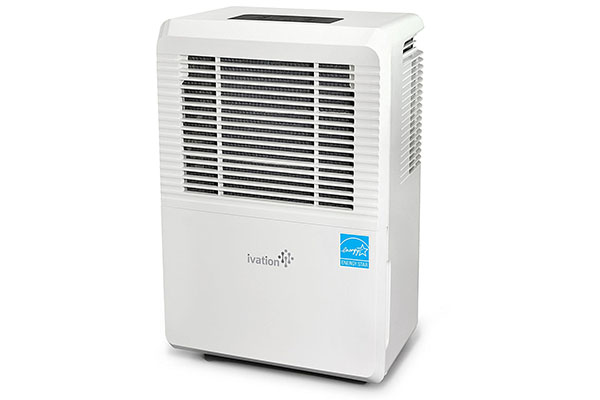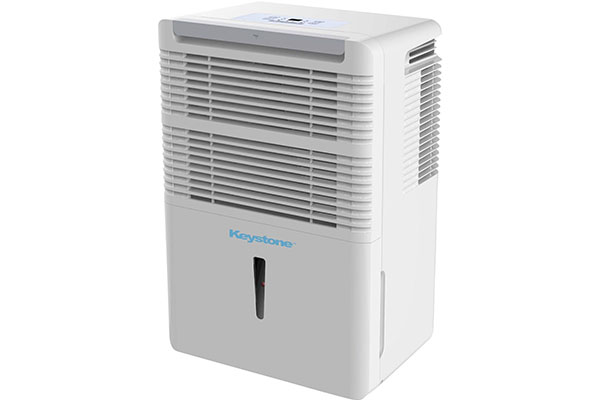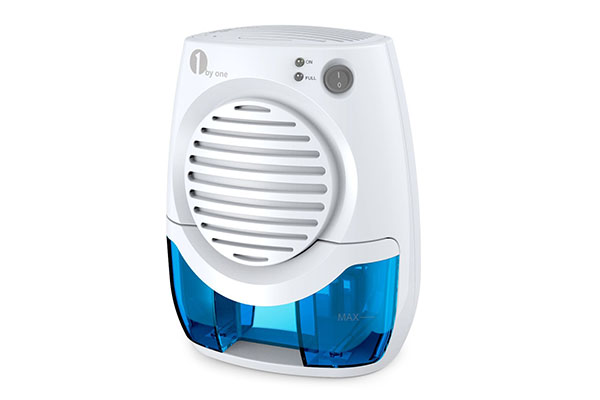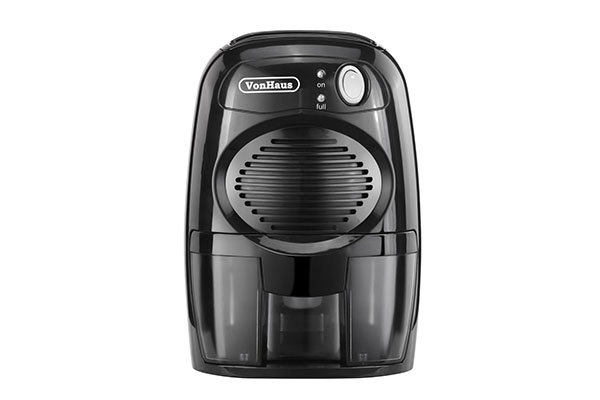Are you having difficulty removing excess moisture in your basement, laundry room and other damp areas? You will need the best dehumidifier to help you with this daunting task.
The best models can eliminate moisture quickly and effectively, even in the toughest situations. They are also more energy efficient compared to older and low-quality models, which means you will also see savings in your operating costs.
- Ivation 70 Pint Energy Star Dehumidifier
- Keystone KSTAD50B Energy Star Dehumidifier
- Pro Breeze™ Electric Dehumidifier
- DeLonghi DD45E Energy Star Dehumidifier
- 1byone 400ML Powerful Thermo-electric Dehumidifier
- VonHaus Compact Mini Portable Black Air Dehumidifier
- Winix 70BT Dehumidifier
- Frigidaire FFAD7033R1 Energy Star Dehumidifier
- Whynter RPD-302W Energy Star Portable Dehumidifier
- Seneo Mini Air Dehumidifier
Dehumidifier Reviews
Ivation 70 Pint Energy Star Dehumidifier

With the Ivation Energy Star Dehumidifier, you can keep open spaces comfortable and cool throughout the day. It can cover 4500 square feet and remove 70 pints of moisture each day. It also prevents the formation of mildew and mold – keeping the air in your home clean.
>>>> Click Here To See Customer Reviews & Current Price <<<<
Keystone KSTAD50B Energy Star Dehumidifier

Capable of removing up to 50 pints of moisture each day from a space that spans 3000 square feet, you will be surprised to know that the Keystone KSTAD50B is also energy efficient. In fact, it’s Energy Star Qualified. It also features different settings to suit every need – Normal, Turbo and Auto-Defrost.
>>>> Click Here To See Customer Reviews & Current Price <<<<
Pro Breeze™ Electric Dehumidifier

The Pro Breeze Electric Dehumidifier is lightweight and portable, but packs an even punch when it comes to power. It can remove up to 500ml of moisture from the air and comes with a 1500ml tank capacity. The auto-shut off ensures safety when the max capacity is reached.
>>>> Click Here To See Customer Reviews & Current Price <<<<
DeLonghi DD45E Energy Star Dehumidifier

The DeLonghi DD45E is more than just your basic dehumidifier. With its 7-liter tank control system, it can keep any room cool all day. It also has adjustable humidistat and thermostat, giving you more control in terms of temperature.
>>>> Click Here To See Customer Reviews & Current Price <<<<
1byone 400ML Powerful Thermo-electric Dehumidifier

Smaller than most, but no less powerful, 1byone’s Thermoelectric humidifier is capable of absorbing about 170ml of moisture from the air. It can also cover 883 cubic feet and works using the Peltier Technology and is designed with no moving parts and no compressor.
>>>> Click Here To See Customer Reviews & Current Price <<<<
VonHaus Compact Mini Portable Black Air Dehumidifier

For smaller spaces, you’ll need a dehumidifier that doesn’t take up much surface area. This Dehumidifier from VonHaus is effective in protecting mold growth and removing and dampness from the air. It has extra 0.25L of water and features an auto-shut off function, which ensures safety.
>>>> Click Here To See Customer Reviews & Current Price <<<<
Winix 70BT Dehumidifier

The Winix 70T Dehumidifier features an antimicrobial cleanse coating, preventing bacterial growth on the filter itself. It can remove 70 pints of moisture from the air and features auto defrost, auto operation and auto shut off functions for ease of use.
>>>> Click Here To See Customer Reviews & Current Price <<<<
Frigidaire FFAD7033R1 Energy Star Dehumidifier

Energy efficient and capable of removing 70 pints of water per day, the Frigidaire FFAD7033R1 can also help remove mildew and mold from the air. It also features ready-select electronic controls and a 24-hour timer for safety and convenience.
>>>> Click Here To See Customer Reviews & Current Price <<<<
Whynter RPD-302W Energy Star Portable Dehumidifier

The Whynter RPD-302W is one dehumidifier you can easily move around any space. Bring it into the living room or move it into your bedroom. Capable of removing 30 pints of moisture in the air, it has an auto-defrosting feature, which prevents any frost build-up within the unit.
>>>> Click Here To See Customer Reviews & Current Price <<<<
Seneo Mini Air Dehumidifier

This dehumidifier from Seneo is great for smaller spaces, especially areas such as the closet or pantry. It can remove 250ml of humidity and provides worry-free use since it also has an auto-shut off feature. Lastly, it is energy efficient, making it 100% eco-friendly.
>>> Click Here To See Customer Reviews & Current Price <<<<
Types of Dehumidifiers
Dehumidifiers control the indoor humidity level to keep your environment comfortable. Humidity controlis necessary to prevent the growth of molds and mildew, and to prevent damage to drywall and other home furnishings.
The two types of dehumidifiers designed for home use are the Desiccant and the Refrigerant Dehumidifiers. Both work efficiently in keeping humidity levels low but each has certain advantages over the other.
The Desiccant Dehumidifier employs a desiccant wheel that contains granular silica. The porous silica absorbs water from the air, which is then expelled outside through heat and appropriate ducting.
Desiccant dehumidifiers are more economical at lower moisture and temperature levels. This typeis best if you want tomaintain indoor humidity levels from 1% to 45%.
The Refrigerant Dehumidifier is equipped with a compact refrigeration system. It is equipped with fans that move the air in and out of the unit, and a refrigerated coil that collects moisture from the air.
This dehumidifier typeis cheaper to run at high temperature and moisture levels. It is not recommended for humidity levels below 45% because its efficiency is reduced by the possible formation of ice in the coils.
How to Select a Dehumidifier
High humidity particularly in the basement and laundry room promotes the growth of molds that produce musty odor. Consider the following factors when choosing a unit for these areas in your house.
- The ideal humidity level in the home is 50%. Thus, the refrigerant dehumidifier is most recommended, except in rooms where you want lower humidity levels to protect costly furnishings.
- Measure the area you wish to dehumidify. Suppliers provide a guide that will help you choose the right capacity model based on the room size.
- The size of the dehumidifier is based on its water removal capacity, expressed in the number of pints of water that it can extract from the room in one day.
- A water collection pan is provided for each unit, which you have to manually empty. You can opt to have ducting installed to direct the collected water into a drain.
- Check the energy performance of the dehumidifier. This indicates the efficiency of the model, measured by the quantity of water extracted per hour versus the power consumption.
How to Maintain Your Dehumidifier
Operation
- Turn the unit off when cleaning or emptying the pan. Observe a 10-minute interval between turning off and on to avoid short circuiting the unit.
- Empty the condensate pan daily. Most units automatically shut-off when the water container is full, causing the humidity level in the room to rise.
- Clean the condensate pan regularly to prevent the growth of microbes. If you use a drain pipe, check to ensure that there are no kinks or blockage in the line.
- Inspect and clean the dehumidifier coils at least once per year. Use a soft-bristle brush in cleaning to avoid damage to the coils. Do not get the coils wet.
Storage
- Empty and clean the water pan. Disconnect and clean the hose used to drain water out. Disinfect these items before storing to prevent the growth of microbes.
- Remove the filter and either discard or wash it clean. Clean the unit, allow it to dry, and then store it carefully in a cool, dry place.
How a Dehumidifier Works
A dehumidifier removes excessive moisture from damp and humid areas of the house. Lowering room humidity deters the growth of molds that cause musty odors.
In the refrigerant dehumidifier, a fan moves moisture laden air into the coil. Moisture from the air condenses on the coil, creating water droplets that are collected in a pan.
The drier, dehumidified air is then redistributed back into the environment through the fan. This water removal cycle continues until the humidity level reaches a pre-set value.
The desiccant dehumidifier works similarly.In place of the coil, porous silica absorbs moisture from the air. A fan passes heated air through the silica to remove and expel the collected moisture.
Dehumidifiers are controlled by a humidistat, an electronic device that detects the amount of moisture in the air.The humidistat functions as a sensor that shuts down or turns on the dehumidifier.
The dehumidifier extracts water when the humidity level is higher that the humidistat setting. Once the humidity level has stabilized, the unit will intermittently shut down or turn on to maintain the desired humidity.